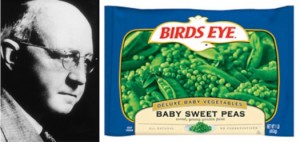
A man of vision, perseverance and curiosity
Having worked for Birds Eye on and off for the last 15 years and knowing something about Clarence Birdeye I thought I ought to find out the full story. Having done my research I can now say he clearly was…
A man of vision, perseverance and curiosity
Clarence Birdseye was a man of vision, perseverance and above all, curiosity. By the time he died on October 7 1956, he held roughly 300 patents including ones for incandescent lighting, a harpoon for marking whales, an infrared heating process, a process for dehydrating food and a technique for converting sugar cane waste into paper pulp. He wrote a book on wildflowers, and was an expert at Chinese checkers.
He once said “I have more hobbies than the law allows. Some are sissy. ,Some have hair on their chest”.
However he is best known for something completely different – US Patent #1,773,079; a double belt fast freezing machine, an invention that gave birth to today’s frozen food industry and the brand that still bears his name.
Clarence Birdseye was born in New York in 1886. He was the sixth of nineteen children! Interested in zoology and botany he enrolled as a student at Amherst College but dropped out before the end of the course due to financial difficulties.
He began a career as a taxidermist, but his curiosity drove him to try his hand as an “assistant naturalist” and he later worked with entomologist Willard Van Orsdel King. Clarence’s role was to capture several hundred small mammals from which King removed several thousand ticks. King used them in his research which helped to identify the ticks as the cause of Rocky Mountain spotted fever.
 Deciding he wanted a new challenge Birdseye’s accepted a field assignment in Labrador in the Dominion of Newfoundland (now part of Canada).
Deciding he wanted a new challenge Birdseye’s accepted a field assignment in Labrador in the Dominion of Newfoundland (now part of Canada).
It was here that he noticed that the local Inuit tribespeople would freeze the fish they caught under very thick layers of ice. This, combined with the -40°C weather, meant the fish froze almost instantly but more importantly when the fish was thawed out and cooked it tasted fresh and delicious.
He immediately recognised the potential as the quality was far, far higher than that the frozen seafood that was being sold in New York.
In 1922, having conducted fish-freezing experiments at the Clothel Refrigerating Company, he started using chilled air (at -43°C) to freeze fish fillets and established his own company, Birdseye Seafoods Inc., but in 1924 the company went bankrupt due to a lack of demand.
He refused to give up and later that same year he developed an entirely new process which involved packing fish into cartons, then freezing these between two refrigerated surfaces, all done under pressure. Birdseye created a new company, the General Seafood Corporation, to promote this method.
In 1925 the General Seafood Corporation moved to Gloucester, Massachusetts where it employed Birdseye’s further refinement on his new method; the “double belt freezer”, in which cold brine chilled a pair of stainless steel belts carrying packaged fish, freezing the fish even more quickly.
It was this invention that was to receive US Patent #1,773,079.
This time his company proved a success as the quicker frozen fish produced better end results and by 1927 he began to extend the process to quick-freezing of meat, poultry, fruit, and vegetables.
In 1929, Birdseye sold his company and accompanying patents for $22 million to Goldman Sachs and the Postum Company, which eventually became General Foods Corporation, and which in turn founded the Birds Eye Frozen Food Company.
Clarence continued to work with the company as a consultant, further developing frozen food technology, but now he also had the time and money to indulge his curiosity in all his other ‘hobbies’.